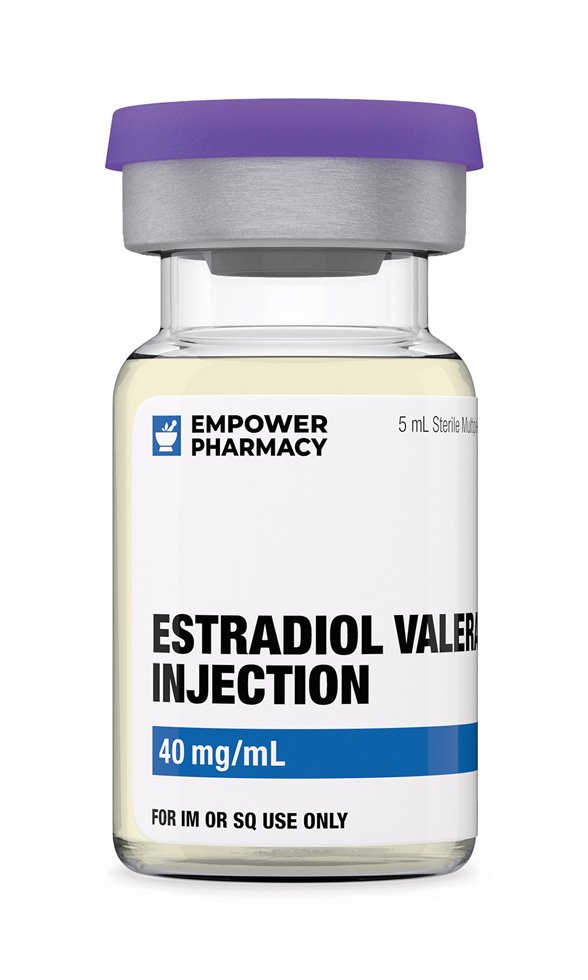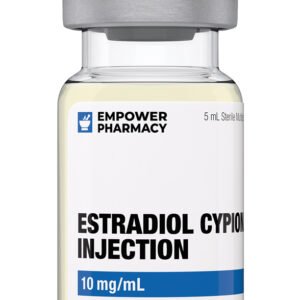A variety of endocrine and urogenital effects can occur during therapy with estradiol. Changes in sexuality include libido increase or libido decrease. Positive changes in libido may occur as a result of improvements in vulvar and vaginal atrophy in postmenopausal women. Vaginal changes such as discharge or irritation, vaginitis, cervicitis, or changes in cervical erosion (e.g., cervical ectropion) may appear. Vulvovaginal or vaginal candidiasis or other mycotic infections may occur infrequently with systemic or vaginal estrogen therapy. In a clinical trial of postmenopausal women to compare estradiol vaginal tablets to placebo, vulvovaginal mycotic infection occurred in 8% of estradiol-treated patients vs. 3% with placebo. Estrogens may also cause enlargement of uterine leiomyomatas (fibroids), if present. A cystitis like syndrome has also been reported. Changes in vaginal bleeding pattern and abnormal withdrawal bleeding or flow, breakthrough bleeding, spotting, and dysmenorrhea have been noted with estrogens and/or progestins and are commonly reported. In postmenopausal women, changes in uterine bleeding patterns will usually taper and stabilize within 3 to 6 months of beginning cyclic or continuous HRT combinations. Amenorrhea is desirable in many postmenopausal women and not considered to be an adverse effect of estrogen therapy. However, when estrogens are used for the treatment of hypogonadism in premenopausal females, continued amenorrhea may signal a lack of response to estrogen therapy. Unusual vaginal bleeding, menorrhagia, or spotting that persists beyond 6 months in any woman on estrogen therapy should be evaluated by a health care professional. For women who have a uterus, adequate diagnostic measures such as endometrial sampling, when indicated, should be undertaken to rule out malignancy in cases of undiagnosed persistent or recurring abnormal vaginal bleeding. Women who take estrogens should follow current recommendations for periodic pelvic examinations, including Papanicolaou smears when indicated to detect cervical dysplasia.
Mastalgia (breast pain) is a common adverse effect of estrogens such as estradiol. Breast tenderness, breast enlargement, breast discharge, galactorrhea, and fibrocystic breast changes have been reported with estrogens and/or progestin therapy. Gynecomastia may occur in men on estrogen therapy. Patients should report breast changes, lumps, or breast discharge to their health care professionals. All women should receive yearly breast examinations by a healthcare provider and perform monthly breast self-examinations. In addition, mammography examinations should be scheduled based on patient age, risk factors, and prior mammogram results.
Stomach/abdominal pain or cramps, bloating, nausea, and vomiting are common side effects of estrogens such as estradiol; these effects may attenuate with continued treatment. Diarrhea is infrequent with estradiol use. For example, in a clinical trial comparing estradiol vaginal tablet 10 mcg to placebo, diarrhea occurred in 5% of treated postmenopausal women vs. 0% of those receiving placebo. Consider benign hepatic adenoma if gastrointestinal symptoms such as abdominal pain/tenderness, abdominal mass, or hypovolemic shock are present, as an adenoma may rupture and cause intraabdominal hemorrhage. Benign hepatic adenomas appear to be associated with the use of oral contraceptives, and enlargement of hepatic hemangiomas has been reported with estrogen and/or progestin therapies. Pancreatitis and colitis have also been reported; high dose estrogens have been associated with ischemic colitis (bowel ischemia) with mesenteric vein thrombus secondary to hypercoagulability a reported potential mechanism. In patients with preexisting hypertriglyceridemia, estrogen therapy may be associated with elevations of plasma triglycerides leading to pancreatitis and other complications. Additionally, GI obstruction of the bowel has been reported in patients using the estradiol vaginal ring. Estrogens enhance hepatic lipoprotein uptake and inhibit bile acid synthesis, resulting in increased concentration of cholesterol in the bile which can lead to cholelithiasis, biliary obstruction, and cholestasis. Cholestatic jaundice and an increased incidence of gallbladder disease have also been reported. A 2- to 4-fold increase in the risk of gallbladder disease requiring surgery (e.g., cholecystitis) in postmenopausal women receiving estrogens has been reported. Estrogens may be poorly metabolized in patients with impaired liver function. For patients with a history of cholestatic jaundice associated with past estrogen use or with pregnancy, use estradiol cautiously. If cholestatic jaundice recurs, discontinue the estrogen. Rare adverse reactions include hepatitis (and elevated hepatic enzymes). Estrogens may induce peliosis hepatis, a very rare consequence of taking estrogens and combined oral contraceptives that is characterized by the presence of blood-filled spaces. Persistent or severe abdominal symptoms should be evaluated by a medical professional.
Deep and superficial venous thrombosis, pulmonary embolism, thrombophlebitis, myocardial infarction, and stroke have been reported with estrogens and/or progestin therapy. The use of estrogens in postmenopausal women, with or without a progestin, carries a risk for thromboembolism, and cardiovascular events such as myocardial infarction (MI) or stroke. Detailed information regarding what is known about thromboembolic and cardiovascular risk in postmenopausal women is available in the boxed warnings and precautions section of the product labeling for the products, as these risks must be considered prior to use of HRT in women, and with consideration to age and other risk factors for these events. Risks vary with the use of estrogen-alone vs. use of estrogen with progestin therapy. Should any of these events occur or be suspected, discontinue the estrogen or estrogen-progestin therapy immediately.
Estrogens such as estradiol can cause sodium and fluid retention, resulting in peripheral edema or mild weight gain. They should be prescribed cautiously to patients in whom the presence of edema would be detrimental. In addition, estrogens can slightly increase blood pressure, occasionally causing hypertension; data indicate in most patients the change is not clinically significant. In a small number of case reports, substantial increases in blood pressure have been attributed to idiosyncratic reactions to estrogens such as estradiol. In a large, randomized, placebo-controlled clinical trial, a generalized effect of estrogens on blood pressure was not seen. In the PEPI trial, postmenopausal women 45 to 65 years of age randomized to any hormone replacement therapy regimen experienced increases in both systolic and diastolic blood pressure of 3% to 5% after the first year of treatment, but the increases were not statistically different from placebo. Monitor blood pressure at regular intervals with estrogen use.
Headache, with no other symptoms, has been noted with use of estrogens such as estradiol, including with vaginal therapy. For example, headache (5% to 7%) was the most common side effect noted with use of an estradiol vaginal insert for dyspareunia. Headache with no other symptoms occurred at an average incidence range of 5% to 21% with various systemic and transdermal estradiol treatments in postmenopausal women. A severe headache with focal neurologic changes may be a warning sign of a serious adverse event such as a stroke or retinal problems (e.g., thrombosis) in the eye. Discontinue the estrogen pending examination if there is sudden partial or complete loss of vision or new, severe, sudden onset of headache or migraine with focal neurologic changes. If examination reveals a serious event, estrogens should be permanently discontinued. The relationship of headache, specifically migraine headache, and the administration of estrogens is not clearly defined. A number of changes can occur when a woman initiates HRT and include 1) migraines can appear for the first time, 2) a change in frequency, severity and duration of migraine headaches may be seen, or 3) an improvement or decrease in the occurrence of migraine headaches. Such adverse events are not frequent. When initiating estrogens, such as estradiol, an individual’s headache pattern should be observed and, if migraines worsen, consider discontinuing therapy.
Mental depression, nervousness or anxiety, mood disturbances such as emotional lability and irritability have been reported with estrogens such as estradiol and/or progestin therapy. Complaints of insomnia or fatigue may be associated with the underlying menopausal complaints or may be associated with treatment. Women with a history of depression may need special monitoring. If significant depression occurs, estradiol should be discontinued.
A variety of dermatologic or allergic reactions have been reported with use of estrogens, such as estradiol. Melasma, in the form of tan or brown patches, may develop on the forehead, cheeks, temples and upper lip; melasma may persist after the drug is discontinued. In some cases, estrogens may induce or aggravate an existing acne vulgaris. Erythema multiforme, erythema nodosum, hemorrhagic eruption, loss of scalp hair (alopecia), hirsutism, pruritus, maculopapular rash, urticaria, angioedema, and anaphylactoid reactions have been reported with estrogens and/or progestins. Estradiol transdermal systems may cause localized bleeding, hematoma (bruising), burning, skin irritation, xerosis, eczema, edema, erythema, inflammation, pain, vesicular rash, or rash (unspecified). Other dermal reactions reported postmarketing with estradiol transdermal systems include, paresthesias, skin discoloration or pigmentation changes, and swelling. To help reduce the chance of skin redness or skin irritation, wait at least 1 week before the patient reuses a skin site for transdermal patch application. Estradiol topical emulsions and sprays have also been associated with pruritus or skin irritation during clinical trials. During postmarketing surveillance, estradiol spray (Evamist) has been associated with nipple and areola skin discoloration, usually occurring on the same side as the inner arm where the product was applied; xerosis has also been reported. Vaginal therapy with estradiol may cause localized itching or irritation; in one clinical trial during use of 10 mcg vaginal tablets, vulvovaginal pruritus occurred in 8% of treated patients compared to 2% of those receiving placebo.
Some women taking estrogens, including estradiol, notice tenderness, swelling, or minor bleeding of their gums, which may lead to gingivitis. Proper attention to oral care and regular dental visits are recommended.
Retinal thrombosis has been reported in patients receiving estrogens such as estradiol. Discontinue medication pending examination if there is sudden visual impairment either partial or complete or a sudden onset of proptosis, diplopia, or migraine with focal neurologic changes. If examination reveals papilledema, visual loss, or retinal vascular lesions, permanently discontinue estrogens. Exogenous estrogen use can cause a conical cornea to develop from steepening or increased curvature of the cornea, caused by thinning of the stroma. Patients with contact lenses may develop intolerance to their lenses.
Reduced carbohydrate tolerance and potentially hyperglycemia has been reported with estrogens and/or progestin therapy. Cautious use of estrogens such as estradiol in patients with diabetes is advised, as estrogens may cause an exacerbation of diabetes mellitus.Limited clinical studies of estrogen regimens have not noted significant alterations in glucose metabolism in healthy post-menopausal women. Further, in women without diabetes, estrogens appear to have little to no effect on fasting blood glucose.
Leg muscle cramps, arthralgia, and hypocalcemia have been reported with estrogen and/or progestin therapy. Back pain has been reported within an overall incidence range of 3.3% to 11% with various estradiol formulations, including oral, transdermal, topical and vaginal products.
Hormone replacement therapy (HRT), both estrogen/progestin combination therapy and estrogen alone therapy, fails to prevent mild impaired cognition (memory loss) and is positively associated with the risk of developing dementia in women 65 years and older; do not use HRT to prevent or treat dementia or preserve cognition (memory). When data from the 2 populations in the WHIMS estrogen-alone and estrogen plus progestin ancillary studies were pooled as planned in the WHIMS protocol, the reported overall relative risk for probable dementia was 1.76 (95% CI 1.19 to 2.60, p = 0.005). Since both ancillary studies were conducted in women 65 to 79 years of age, it is unknown whether these findings apply to younger postmenopausal women. In the Women’s Health Initiative Memory Study (WHIMS) estrogen plus progestin ancillary study, a population of 4,532 postmenopausal women 65 to 79 years of age was randomized to daily estrogen plus progestin or placebo. After an average follow-up of 4 years, 40 women in the estrogen plus progestin group and 21 women in the placebo group were diagnosed with probable dementia. The relative risk of probable dementia for estrogen plus progestin vs. placebo was 2.05 (95% CI, 1.21 to 3.48). The absolute risk of probable dementia for estrogen plus progestin vs. placebo was 45 vs. 22 cases per 10,000 women-years. In the WHIMS estrogen-alone ancillary study of WHI, a population of 2,947 hysterectomized women 65 to 79 years of age was randomized to daily estrogen-alone or placebo. After an average follow-up of 5.2 years, 28 women in the estrogen-alone group and 19 women in the placebo group were diagnosed with probable dementia. The relative risk of probable dementia for estrogen-alone vs. placebo was 1.49 (95% CI, 0.83 to 2.66). The absolute risk of probable dementia for estrogen-alone versus placebo was 37 vs. 25 cases per 10,000 women-years.
In women with a history of cardiovascular disease, the use of estrogen and progestin combination therapy increases the risk of developing urinary incontinence. Patients in the HERS study who did not have urinary incontinence prior to the studies initiation were observed to determine if hormone replacement therapy was helpful in preventing urinary incontinence. The study found that women who received estrogen/progestin therapy were almost twice as likely as patients receiving placebo to develop urge incontinence and 3 times as likely to develop stress incontinence after 1 year of treatment. At 4 years, the effect of hormone replacement therapy became even more pronounced, increasing the risk to 3.23 for urge incontinence and to 4.81 for stress incontinence. The applicability of these findings to women who use estrogen alone with estradiol is unclear.
Estradiol vaginal ring inserts do not dissolve, and remain inserted into the vaginal for prolonged periods. Toxic-shock syndrome (TSS) has been reported in women using vaginal rings containing estradiol. TSS is a rare but life threatening complication of bacterial infection; often it results from toxins produced by Staphylococcus aureus bacteria, but may also be caused by toxins from group A streptococcus. Examples of signs/symptoms of TSS include fever, nausea, vomiting, diarrhea, muscle pain, dizziness, fainting, or a sunburn-rash on the face and body. Patients experiencing any of these effects should be instructed to contact their prescriber immediately.
Vaginal estradiol products may cause localized vaginal pruritus/itching or rarely, vaginal irritation. In a clinical trial comparing estradiol vaginal tablet inserts 10 mcg to placebo, vulvovaginal pruritus occurred in 8% of treated patients vs. 2% of patients receiving placebo. Vaginal ring inserts with estradiol do not dissolve, and remain inserted for prolonged treatment durations. Sometimes, these insertions lead to complications with the ring device. A few cases of inadvertent ring insertion into the urinary bladder or adherence to the bladder wall, which may require surgical removal, have been reported for women using vaginal ring inserts. Adherence of the vaginal rings to the vaginal wall, making removal of the ring difficult, has been reported; some cases have required surgical removal. Vaginal or bladder wall ulceration or erosion may occur with use of the vaginal rings. Symptoms of vaginal erosion and vaginal ulceration have included vaginal pain or irritation, erythema, abrasion, and/or spotting. Vaginal pain upon removal or difficulty removing the vaginal ring should be evaluated by a medical professional. If erosion or ulceration occur, consider temporarily discontinuing the vaginal ring until healing is complete. Also, carefully evaluate unusual vaginal discharge, vaginal pain, or persistent unexplained urinary symptoms such as bladder discomfort in patients using vaginal estradiol products.
There is an association of unopposed estrogen therapy and endometrial hyperplasia in women with an intact uterus. Unopposed estrogen therapy can promote endometrial hyperplasia in approximately 10% of patients with an intact uterus, and thus increase the risk of endometrial cancer. Adding a progestin to estrogen therapy has been shown to reduce, but not eliminate, the risk of endometrial hyperplasia, which may be a precursor to endometrial cancer. With concurrent progestin use (cyclically or continuously), the incidence of endometrial hyperplasia due to estradiol is estimated to be 1% or less. Sequential combined or continuous transdermal estrogen-progestin therapy is as effective as oral combined therapy in preventing the development of endometrial hyperplasia. Vaginal use of estrogen does result in systemic absorption, and cases of endometrial hyperplasia have been reported postmarketing in estrogen-alone users. Clinical surveillance of all women using estrogen-alone or estrogen plus progestin therapy is important. Adequate diagnostic measures, including directed or random endometrial sampling when indicated, should be undertaken to rule out malignancy in postmenopausal women with undiagnosed persistent or recurring abnormal vaginal bleeding. The reported endometrial cancer risk among unopposed estrogen users is about 2- to 12-times greater than in non-users, and appears dependent on duration of treatment and on estrogen dose. Most studies show no significant increased risk associated with use of estrogens for less than 1 year. The greatest risk appears associated with prolonged use, with increased risks of 15-to 24-fold for 5 to 10 years or more, and this risk has been shown to persist for at least 8 to 15 years after estrogen therapy is discontinued. There is no evidence that the use of natural estrogens results in a different endometrial risk profile than synthetic estrogens of equivalent estrogen dose.
Numerous epidemiologic studies have examined the effects of estrogen and estrogen-progestin hormone replacement therapy (HRT) on the development of new primary malignancy (e.g., breast cancer, endometrial cancer, ovarian cancer) in postmenopausal women. Detailed clinical study information regarding what is known about cancer risk in postmenopausal women is available in the boxed warnings and precautions section of the product labeling for the products, as these risks must be considered prior to use of HRT in women, and with consideration to age and other risk factors for these events. The risk for endometrial cancer is increased in women who take unopposed estrogen. Adding a progestin to estrogen therapy has been shown to reduce, but not eliminate, the risk of endometrial hyperplasia, which may be a precursor to endometrial cancer. The Women’s Health Initiative (WHI) estrogen plus progestin study reported increased risks of invasive breast cancer in patients taking combined estrogen-progestin HRT vs. placebo. The potential risk of breast cancer may increase with longer duration of use. Women who used hormonal therapy for menopausal symptoms also had an increased risk for ovarian cancer, but data are still uncertain if risk is associated with a specific duration of use.
Estrogen administration such as estradiol may lead to severe hypercalcemia in patients with breast cancer and bone metastases. If hypercalcemia occurs, discontinue estradiol and take appropriate measures to reduce the serum calcium concentration.
Estradiol cypionate or estradiol valerate injections may cause an injection site reaction, which may include erythema and mild pain and rarely may cause sterile abscess. Never inject these injections intravenously, they are for intramuscular use only. These injections are formulated in oil, and inadvertent intravenous administration may result in pulmonary oil microembolism and serious morbidity.
Estradiol is contraindicated for use during known or suspected pregnancy. Little or no increased risk of birth defects appears to exist in children born to women who have used estrogens and progestins from oral contraceptives inadvertently during early pregnancy.Estrogens are known to cause teratogenesis with continued use during pregnancy. Increased risk of a wide variety of fetal abnormalities, including modified development of sexual organs, cardiovascular anomalies and limb defects, have been reported following the use of estrogens in pregnant women. The use of diethylstilbestrol, DES is well known for creating disturbances in the reproductive systems of both male and female offspring; similar disturbances are reported to occur in female offspring of rats exposed to estradiol during gestation. In any patient in whom pregnancy is suspected, pregnancy should be ruled out before continuing estradiol use.






Reviews
There are no reviews yet.